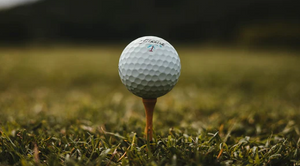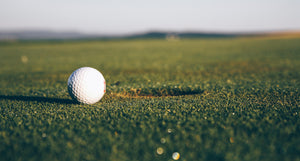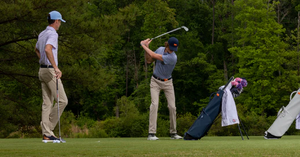How To Hit a Draw in Golf With Drivers and Irons
Mastering the draw is akin to wielding a strategic weapon on the course. A draw, a deliberate and controlled shot, involves crafting a subtle curvature in the ball's flight path. Tailored to a golfer's dominant hand, it's a dance from right to left for right-handed players and left to right for their left-handed counterparts. This artistry becomes crucial when navigating challenges like doglegs or deftly maneuvering around obstacles.
What Is a Draw in Golf?
In golf, a draw refers to a deliberate and controlled shot where golfers intentionally shape the ball's flight path with a slight curvature. For right-handed golfers, this entails a gentle curve from right to left, while for left-handed golfers, it involves a curve from left to right. Golfers often employ the drawing technique to adeptly navigate the course, especially when faced with challenges like doglegs or the need to maneuver shots around obstacles.
Executing a draw involves making nuanced adjustments to various aspects of the golfer's setup, grip, and swing. Firstly, for setup, golfers may slightly position their feet, shoulders, and hips to the right of the target (for right-handed golfers), encouraging an inside-to-out swing path conducive to producing a draw.
The grip is critical in controlling the clubface, with golfers often opting for a slightly stronger grip. In this grip, the top hand (left hand for right-handed golfers) is turned to the right on the club handle, helping close the clubface at impact and facilitating the draw.
A key component of hitting a draw is maintaining the ideal inside-to-out swing path during the downswing. This hit means the club approaches the ball from inside the target line, fostering the desired right-to-left curvature. Additionally, ensuring a square or slightly closed clubface at impact is essential for a successful draw.
How Do You Hit a Draw?
With a Driver
Generating a draw with a driver in golf demands a systematic strategy involving precise adjustments to your setup, grip, and swing to create a controlled right-to-left ball trajectory intentionally.
To initiate the setup, position the golf ball just inside your left heel (for right-handed golfers). This placement encourages an upward strike, crucial for achieving the desired draw. Additionally, ensure your stance is slightly to the right of the target, aligning your feet, shoulders, and hips accordingly.
Transitioning to the grip, opt for a marginally tighter grip than your usual hold. Rotate your top hand (left hand for right-handed golfers) to the right on the club handle. A firmer grip aids in closing the clubface at impact, facilitating the draw. Confirm that the V formed by your thumb and forefinger on both hands points between your chin and right shoulder (for right-handed golfers) for the desired grip alignment.
During the backswing, focus on maintaining a square clubface position. Aim to keep the clubface directed at the ball for an extended period during the takeaway. Foster a connected swing by rotating your body and the club back with your arms, avoiding excessive hand manipulation. This swing style encourages a square clubface and contributes to a consistently effective draw.
As you initiate the downswing, emphasize rotating your hips toward the target. This hip rotation is crucial for creating an inside-to-out swing path, a key factor in successfully hitting a draw with your driver.
With an Iron
Begin by adjusting your setup. Position the golf ball just off the inside of your front foot (left foot for right-handed golfers). Ensure your feet, hips, and shoulders are aligned parallel to the target line. Unlike a draw with a driver, there's no need to modify your stance by dropping your back foot.
For a draw with an iron, make a slight grip adjustment. Adopt a slightly firmer grip to encourage a closed clubface at impact. This entails turning your top hand (left hand for right-handed golfers) more to the right on the club handle. Verify that the V formed by your thumb and forefinger points towards your trail shoulder.
Maintain control of the clubface. Focus on keeping the clubface square in your backswing. Ensure the clubface points at the ball for as long as possible on the takeaway. Also, maintain a square or slightly closed clubface at the top of your backswing, which is critical for setting up the draw.
Execute an inside-to-out swing. Create a draw with an inside-to-out golf swing. To achieve this, keep the clubface square and rotate back correctly. This rotation will enable you to drop the club inside and attack the "inside" of the golf ball. Visualize hitting the ball at 4 pm on the clock dial, creating the inside-to-square club path and proper draw spin on the ball at impact.
Maintain connection. Keep your arms and body in sync during the swing, and use your larger muscles. Many golfers rely too much on their arms and hands to deliver the club to impact. Instead, utilize a Swing Align device to help you stay connected, giving the club more power, speed, and accuracy.
Finish your swing with strength. Making an aggressive follow-through is crucial to hitting a draw. Decelerating into the ball or the follow-through can alter your clubface or path. Drive through to the finish, rotating your chest to face the target.
What's the Difference Between a Draw and a Fade?
A draw and a fade represent distinct shot shapes that golfers purposefully induce to manipulate the ball's flight path. Grasping the disparities between a draw and a fade empowers golfers to strategically adapt their shots based on course conditions and specific challenges.
A draw is a shot that, for a right-handed golfer, commences to the right of the target and gently arcs back to the left, ultimately concluding closer to the target line. For left-handed golfers, the ball initiates its trajectory to the left and gracefully curves back to the right.
Conversely, a fade is a shot that, for a right-handed golfer, begins to the left of the target and gently curves back to the right, concluding closer to the target line. For left-handed golfers, the ball initiates its path to the right and gracefully curves back to the left.
Draw and fade shots offer unique advantages, allowing golfers to rapidly navigate diverse course layouts and confront specific challenges. Mastering the intentional shaping of shots enhances a golfer's versatility and skill set.
Frequently Asked Questions
What Is Meant by a Draw in Golf?
In golf, a draw refers to a shot that, for a right-handed player, starts right off the target and gently curves back to the left, concluding closer to the target line. A controlled right-to-left ball flight characterizes it. The draw is a deliberate technique employed by golfers to shape their shots strategically.
Final Thoughts
Maintaining a square clubface position during the backswing is pivotal in executing a successful draw. This involves keeping the clubface directed at the ball for as long as possible during the takeaway, emphasizing a connected swing driven by body rotation rather than hand manipulation. This approach contributes to a consistent draw.
To master the art of hitting a draw, golfers delve into nuanced adjustments across their setup, grip, and swing. Initiating the process, the setup calls for a slight repositioning of feet, shoulders, and hips to the right of the target (for right-handed golfers), promoting an inside-to-out swing path conducive to the desired draw.



